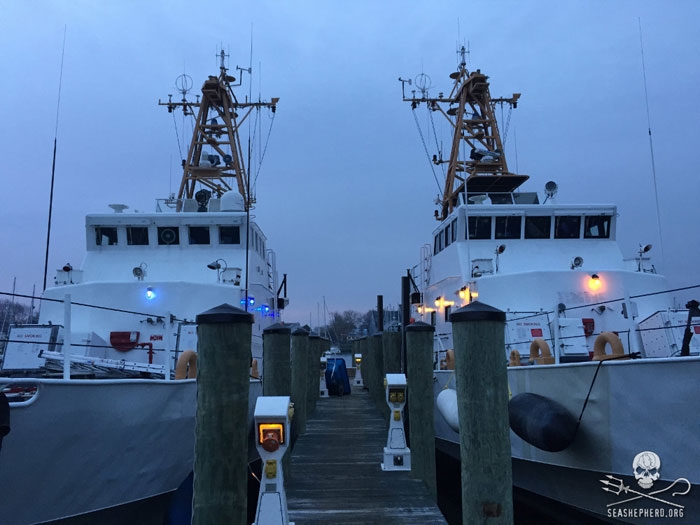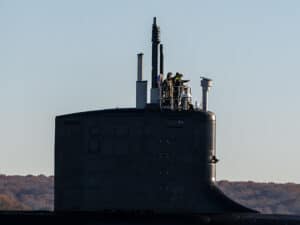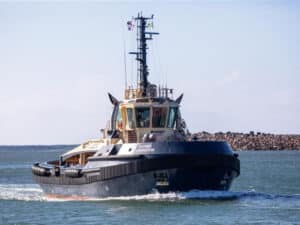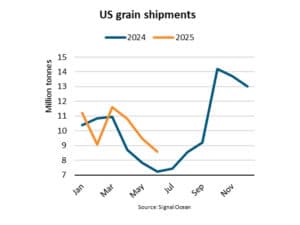
Two former USCG Island Class cutters bought by Sea Shepherd
Written by Nick Blenkey
The Jules Verne and the Farley Mowat docked at sunset
JUNE 3, 2015 — Sea Shepherd Conservation Society has secured two new ships to join what it calls “its international eco-Navy.”
Sea Shepherd uses direct action tactics to protect marine life, notably targeting the Japanese whaling fleet, sealing and shark finning, and its activities have often been characterized as extreme, bringing it criticism from other conservation groups.
This month Sea Shepherd USA revealed that in January it purchased two recently decommissioned U.S. Coast Guard 110-ft Island-class fast patrol vessels, the USCG Block Island and the USCG Pea Island. .
The two ships, now renamed the Jules Verne and the Farley Mowat, purchased in Baltimore, are now berthed in Key West, FL.
Sea Shepherd USA now operates three vessels. In addition to the two newly acquired fast patrol boats there is the sailing ketch the R/V Martin Sheen, currently wrapping up its engagement with Operation Milagro, protecting the endangered vaquita in Mexico’s Sea of Cortez.
The new Farley Mowat replaces the first vessel Farley Mowat that Sea Shepherd purchased in 1997 and retired in 2008 — after it had been seized by the Canadian Government for observing the Canadian seal hunt without a permit. The new vessel was purchased with a bequest left to Sea Shepherd by longtime friend, Sea Shepherd International Chair and Canadian writer Farley Mowat, who passed away a year ago this month.
The Jules Verne is named in honor of the French writer who gave the world the inspiring story of Captain Nemo. The Jules Verne is partially sponsored by supporter John Paul DeJoria’s Peace, Love & Happiness Foundation.
This is not Sea Shepherd’s first purchase of a former USCG vessel. In 1990, the society purchased a 95-ft Cape-class patrol vessel from the U.S. Coast Guard that it named the Edward Abbey. In 1999, the Edward Abbey was renamed the Sirenian and Sea Shepherd donated it as a permanent patrol vessel for the Galapagos National Park Marine Reserve.
“These two ships, the Farley Mowat and the Jules Verne, give Sea Shepherd USA a combination of speed and long-range capabilities,” said Sea Shepherd Founder Captain Paul Watson. “We have already offered the Jules Verne to assist the rangers at Cocos Island National Park Marine Reserve with anti-poaching interventions, 300 miles off the Pacific Coast of Costa Rica, and the Farley Mowat has been offered to patrol the Sea of Cortez in partnership with the government of Mexico to protect the endangered vaquita.”JUNE 3, 2015 — Sea Shepherd Conservation Society has secured two new ships to join what it calls “its international eco-Navy.”
Sea Shepherd uses direct action tactics to protect marine life, notably targeting the Japanese whaling fleet, sealing and shark finning, and its activities have often been characterized as extreme, bringing it criticism from other conservation groups.
This month Sea Shepherd USA revealed that in January it purchased two recently decommissioned U.S. Coast Guard 110-ft Island-class fast patrol vessels, the USCG Block Island and the USCG Pea Island. .
The two ships, now renamed the Jules Verne and the Farley Mowat, purchased in Baltimore, are now berthed in Key West, FL
Sea Shepherd USA now operates three vessels. In addition to the two newly acquired fast patrol boats there is the sailing ketch the R/V Martin Sheen, currently wrapping up its engagement with Operation Milagro, protecting the endangered vaquita in Mexico’s Sea of Cortez.
The new Farley Mowat replaces the first vessel Farley Mowat that Sea Shepherd purchased in 1997 and retired in 2008 — after it had been seized by the Canadian Government for observing the Canadian seal hunt without a permit. The new vessel was purchased with a bequest left to Sea Shepherd by longtime friend, Sea Shepherd International Chair and Canadian writer Farley Mowat, who passed away a year ago this month.The Jules Verne is named in honor of the French writer who gave the world the inspiring story of Captain Nemo. The Jules Verne is partially sponsored by supporter John Paul DeJoria’s Peace, Love & Happiness Foundation.
This is not Sea Shepherd’s first purchase of a former USCG vessel. In 1990, the society purchased a 95-ft Cape-class patrol vessel from the U.S. Coast Guard that it named the Edward Abbey. In 1999, the Edward Abbey was renamed the Sirenian and Sea Shepherd donated it as a permanent patrol vessel for the Galapagos National Park Marine Reserve.
“These two ships, the Farley Mowat and the Jules Verne, give Sea Shepherd USA a combination of speed and long-range capabilities,” said Sea Shepherd Founder Captain Paul Watson. “We have already offered the Jules Verne to assist the rangers at Cocos Island National Park Marine Reserve with anti-poaching interventions, 300 miles off the Pacific Coast of Costa Rica, and the Farley Mowat has been offered to patrol the Sea of Cortez in partnership with the government of Mexico to protect the endangered vaquita.”





Leave a Reply
You must be logged in to post a comment.